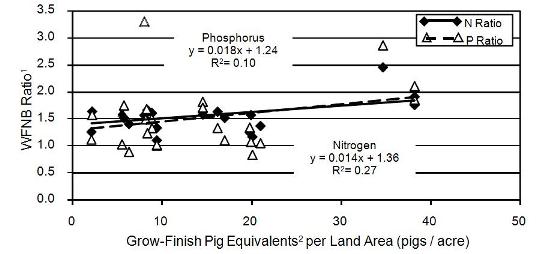| Take Home Message |
| The density of pigs per unit of crop land is of some importance for determining whole farm nutrient balance. Higher densities tend to result in greater imbalances, although the variability observed was only partially explained by pig density. No recommended or threshold value for pig density per crop acre could be identified from the study. |
Click here for introduction to WFNB
The relationship between the numbers of pigs raised on a swine farm to the numbers of acres to support this production unit is often called animal density. This measurement has been used in the past to relate the estimated amount of manure nutrient production from pigs to the amount of land that can utilize these nutrients for productive purposes i.e., crop production. However, using this measurement may give erroneous results because of the variety of nutrient management options available to pork operations. A whole farm nutrient balance (WFNB) study was conducted for two years (2006-2007) on 13 swine farms in the Midwest US. This fact sheet summarizes a comparison of animal density with WFNB or the farms overall measure of nutrient use efficiency. For more information about the farms involved in this study go to Overview of Nutrient Management Lessons Learned. Following are some observations from this study concerning the relationship of pig density to WFNB.
Pig Density
The relationship of pig density (grow-finish pig capacity per acre of available land area that can receive manure applications for crop production) to the WFNB for nitrogen (N) and phosphorus (P) as a ratio of N or P inputs to managed outputs was analyzed for the 13 swine farms during the two year study. Figure 1 shows the results of this relationship. There was a very weak conclusive effect or relationship of pig density per acre of land area on both N and P balance.

1 WFNB Ratio is a ratio of all nutrients, N and P for this summary, that enter the farm (inputs) to all nutrients that exit the farm as managed products (managed outputs). See WFNB Introduction for a more complete explanation.
2 Grow finish equivalents included nursery pigs and sows. Nursery pigs and sows were converted to a grow-finish equivalent based upon a comparison of average feed intake.
Therefore, animal density alone is not effective in describing the nutrient use efficiency as describe by WFNB Ratio of a specific farm. Nutrient balance is also impacted by storage system type, feed program, crop nutrient management plan implementation, and export of manure (see additional fact sheets for details). As noted in Figure 1, there was considerable variation in the relationship of pig density to N and P balance with more variation in P balance than N balance. This reinforces the need to evaluate each specific farm independently for N and P balance considering the unique characteristics of the farm management, resources and other factors that can impact nutrient flow. A spreadsheet is available to determine the WFNB on any specific producer’s swine farm.
Summary
Pig density (pig capacity per acre land) is not a very effective indicator alone for N and P balance on a pork production unit. Many other aspects of the farm must be considered and evaluated to determined direct impact on N and P balance.
Results of On-Farm Measurement of WFNB
Return to Introductory Page for WFNB Resources
Authors: Alan Sutton, Purdue University; Rick Koelsch, University of Nebraska; Joe Lally, Iowa State University
This project was funded by The National Pork Board Project

